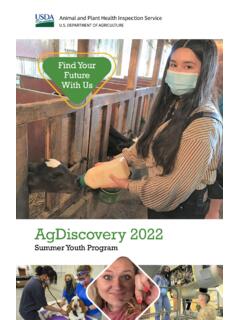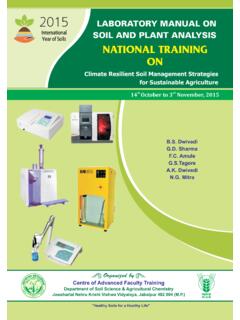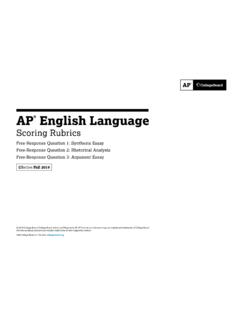Transcription of The Evolution Lab ANSWER KEY
1 The Evolution Lab ANSWER KEYEVOLUTION 1011. c 2. c 3. c 4. Sample ANSWER : The bird is eating the yellow insect. This is probably because it was easier to see and catch than the green one, which is blended in with the leaf. This illustrates natural selection because a variation (green color) is giving some of the insects an advantage that will help them to survive longer and reproduce more frequently than the yellow-colored insects. 5. d MISSION 1: Training TreesIntroductory video:1. c 2. a 3. The common ancestor of B and C 4. A and B: trait 1; B and C: traits 1 and 3 5. From left to right, trees 1, 3, and 4 are equivalent. Red, green, & gecko:6. c 7. They are heterotrophs. 8. Any two of these four trees: 9. Sample ANSWER : Because mushrooms and plants look a lot more alike than do mushrooms and animals, and neither move around like animals do you might think that the mushroom and plant are more closely related than the mushroom and animal.
2 Familiar faces:10. An amniote is an animal whose embryos develop inside the set of protective membranes. The snake and dog are amniotes. 11. Sample ANSWER : Hair Tree of life Vegetarian edition:12. c 13. Sample ANSWER : Because an onion is a vegetable, but bananas and lemons are both yellow fruits you might think that the banana and lemon plants are more closely related than banana plants and onion plants . 1 GeckoPalm treeFlyagaricGeckoPalm treeFlyagaricGeckoPalm treeFlyagaricGeckoPalm treeFlyagaricThe Evolution Lab ANSWER KEYMISSON 2: Fossils: Rocking the EarthIntroductory video: 1. See labeled image2. b Eating dinosaurs for dinner:3. a 4. d 5. a. Correctly labeled tree b. Aves (clade 1), Theropoda (clade 2), Ornithischia (clade 3), and Dinosauria (clade 5) c. Birds are dinosaurs because in addition to being a part of clade Aves, they are a part of clade Dinosauria (clade 5). 2oldestyoungest1413245Tr i c e r a t o p sApatosaurusT.
3 R e xArchaeopteryxLiving birds235 The Evolution Lab ANSWER KEYOne small step:6. It helps them to see and catch prey above them in the water. 7. d 8. This tree, or an equivalent: 9. c Origin of whales:10. a 11. b 12. Sample ANSWER : Because sharks and whales are not closely related and did not inherit these traits from a common ancestor. Whales evolved from tetrapods; sharks did not. 3G/TEDSITuA Ti EThe Evolution Lab ANSWER KEYMISSION 3: DNA Spells EvolutionIntroductory video:1. c 2. c 3. c 4. Sample ANSWER : The more closely related two organisms are, the more similar you d expect their DNA to be. This is because less time has passed since they split from a common ancestor, so fewer mutations will have accumulated. 5. Sample ANSWER : You d have to compare the physical traits of the fossil and living organisms. Frog legs and fish eggs:1. Any two of these four trees: 2. False. Sample explanation: One nucleotide change is not enough to generate all of the changes.
4 In fact, in most cases, a single nucleotide change has absolutely no effect on an organism. One fish, two fish, red fish, lungfish:3. No. The alternative hypothesis based on DNA is that the lungfish is the closest living relative to amphibians. 4. answers will vary. Be sure students provide an explanation for their choice. 5. d Where the tiny wild things are:6. d 7. T. thermophilus and D. radiodurans (must have both to be correct) 8. No, you cannot. Sample explanation: You can only tell the relative timing of changes along a single lineage. So, you could say that the C at position 15 evolved after the C at position 7 along the archaean lineage, but you don t know from this data whether it evolved before or after the T at position 17 in the bacteria lineage. 9. When fossil organisms are part of the group you are studying (You can almost never get DNA from fossils.) 4frogcoelacanthcichlidfrogcoelacanthcich lidfrogcoelacanthcichlidfrogcoelacanthci chlidThe Evolution Lab ANSWER KEYMISSON 4: Biogeography: Where Life LivesIntroductory video:1.
5 Sample ANSWER : They are carried by wind or water from nearby landmasses. 2. b 3. b 4. Sample ANSWER : Populations of the species ancestors were split up and ended up on two different landmasses as the continents broke apart and moved around. Saving Hawaiian treasure:5. d 6. Between 6 and 7 million years ago, blown to the islands by a large storm 7. a 8. A species living only on the island of Hawaii most likely evolved after the one living on multiple islands. Sample explanation: The island of Hawaii formed much later than the islands of Maui and Oahu. The species that lives on multiple islands likely evolved on an older island and recently migrated to the island of Hawaii, whereas the one that lives only on the island of Hawaii likely evolved on that island. Cone rangers:9. Completed table: 10. Bois bouchon and Pino hayuelo 11. It suggests that the climate of present-day Antarctica was once much warmer.
6 12. Because the land mass it was on drifted south toward the pole and the climate got too cold for A. fibrosa to survive 5compound coneslocationcone scales w/o wingssmaller scaly leavessmall fleshy conespollen w/o air sacslarge bladelike leavesA. fibrosaBois bouchonCoral reef pineMonkey puzzle treeNorfolk Island pineParana pinePino hayuelopresent-day AntarcticaChile and ArgentinaBrazilSouth AmericaNew Caledonia(islands near Australia)Norfolk Island (island near Australia)New Caledonia(islands near Australia)The Evolution Lab ANSWER KEYK angas, gliders, and snakes, oh my!:13. Completed table: 14. The yellow rat snake; it is closely related to the others (all mammals) but not itself a mammal 15. Placental mammals: elephant, flying squirrel; marsupial mammals: kangaroo, sugar glider; monotreme mammals: platypus 16. a6locationvertebratepouch warm-blooded gives birth to live youngprolonged development in wombElephantAsia, AfricaEurope, N.
7 America, AsiaAustralia and TasmaniaAustraliaAustraliaN. AmericaKangarooPlatypusRat snakeSugar gliderFlying squirrelThe Evolution Lab ANSWER KEYMISSION 5: Tree of Life and DeathIntroductory video:1. d 2. Sample ANSWER : That the Evolution of one species affects the Evolution of the other 3. b Hosting blood flukes for dinner:4. Completed table: 5. This tree, or an equivalent: 6. The red snapper and its fluke are the outgroup in both; however, the green sea turtle s fluke is more closely related to the human s fluke and the freshwater crocodile s fluke than it is to the freshwater turtle s fluke. 7. Suggested ANSWER : The two trees do not follow the same exact pattern (suggesting cophyly), which they would if there had been no host euzetiH. mehraiS. mansoniG. amoenaS. haematobiusParasiteE. euzetiG. amoenaH. mehraiS. mansoniS. haematobiusred snapperfreshwater crocodilegreen sea turtlehumanfreshwater turtleHostThe Evolution Lab ANSWER KEYF atal fangs:8.
8 Completed table: 9. d 10. b Dawn of a modern pandemic:11. Gorilla SIV 12. a 13. Through the hunting, killing, and eating of illegal ape bushmeat 14. At least three times once from gorillas (HIV-1 P), and twice from different populations of chimpanzees (HIV-1 M, HIV-1 N) 15. Sample ANSWER : Mutations frequently occur when genetic material is replicated, which happens when a virus reproduces. The faster a virus or cell reproduces, the more mutations occur. Mutations are the raw material for Evolution . The more mutations, the more opportunities there are for natural selection or another evolutionary mechanism to affect the population. 8nucleotide at position 8treat with antivenomgap between fangsnucleotide at position 3 AAAACCTTTTTTABCBDD single undertail scalesFierce snakeTaipan snakeTiger snakeBlack whip snakeKing brown snakeUnknown snakeThe Evolution Lab ANSWER KEYMISSION 6: You Evolved, TooIntroductory video:1.
9 C 2. b Planet of the apes:3. d 4. d 5. False. Sample explanation: Gorillas are most closely related to chimpanzees and humans (equally) and more distantly related to orangutans. This is because they share a more recent common ancestor with humans and chimps than they do with orangutans. Back to skull: 6. c 7. b 8. Completed timeline: 9. At least three 10. Sample ANSWER : Humans did not evolve from chimps rather, living chimps and living humans both evolved from a common ancestor. After the split from this common ancestor, many hominin species arose, lived, and went extinct. Inside out of Africa:11. d 12. a 13. Populations of Homo sapiens migrated back to Africa and carried with them Neanderthal DNA, which was then mixed into the populations through interbreeding. Conclusion: Evolution ContinuesAnswers will vary. 9 Homo sapiensH. neanderthalensisHomo erectusA. afarensisPresent1 mya2 mya3 mya4 mya










